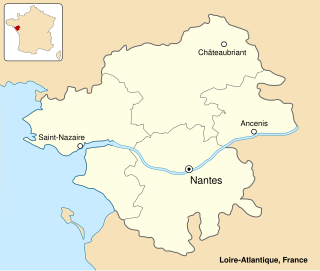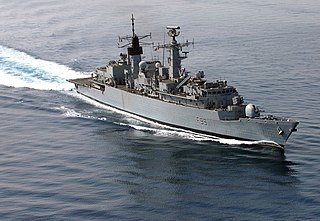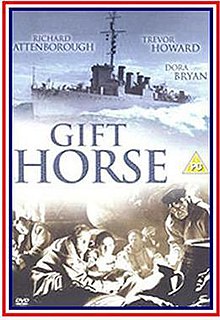Battle Honours
- Atlantic 1941–42
- St Nazaire 1942
Two ships of the Royal Navy have borne the name HMS Campbeltown, after Campbeltown in Scotland, with a third announced:

The St Nazaire Raid or Operation Chariot was a British amphibious attack on the heavily defended Normandie dry dock at St Nazaire in German-occupied France during the Second World War. The operation was undertaken by the Royal Navy (RN) and British Commandos under the auspices of Combined Operations Headquarters on 28 March 1942. St Nazaire was targeted because the loss of its dry dock would force any large German warship in need of repairs, such as Tirpitz, sister ship of Bismarck, to return to home waters by running the gauntlet of the Home Fleet of the Royal Navy and other British forces, via the English Channel or the North Sea.
Seven ships of the Royal Navy have been named HMS Liverpool after the city of Liverpool, whilst another was planned:
Three Royal Navy warships have been named HMSSheffield after the city and county borough of Sheffield, South Yorkshire.
Nine ships of the Royal Navy have been named HMS Amazon, after the mythical female warriors.
Six ships of the Royal Navy have been named HMS Edinburgh, for the Scottish city of Edinburgh. In addition, one ship of the Royal Navy has carried the similar name HMS Duke of Edinburgh.

The Type 22 frigate also known as the Broadsword class was a class of frigates built for the British Royal Navy. Fourteen were built in total, with production divided into three batches.

USS Buchanan (DD-131), named for Franklin Buchanan, was a Wickes-class destroyer in the United States Navy.

HMS Campbeltown was a Batch 3 Type 22 frigate of the British Royal Navy. Built by Cammell Laird Shipbuilders Ltd. in Birkenhead. She was part of the third batch of Type 22s, which were larger than their predecessors and incorporated advanced close-in weapons after lessons learnt from the 1982 Falklands War. She was decommissioned on 7 April 2011.
Nine Royal Navy ships have borne the name HMS Ambuscade:
Seven Royal Navy ships have been named HMS Duncan, after Admiral Adam Duncan, 1st Viscount Duncan of Camperdown, hero of the Battle of Camperdown.

The Town-class destroyers were a group of 50 destroyers of the Royal Navy and the Royal Canadian Navy that were in service during the Second World War. They were transferred from the United States Navy in exchange for military bases in the British West Indies and Newfoundland, as outlined in the Destroyers for Bases Agreement between Britain and United States, signed on 2 September 1940. They were known as "four-pipers" or "four-stackers" because they had four smokestacks (funnels). Later classes of destroyers typically had one or two.
There have been six ships of the Royal Navy named HMS Lancaster:

HMS Campbeltown was a Town-class destroyer of the Royal Navy during the Second World War. She was originally US destroyer USS Buchanan, and, like many other obsolescent U.S. Navy destroyers, she was transferred to the Royal Navy in 1940 as part of the Destroyers for Bases Agreement. Campbeltown became one of the most famous of these ships when she was used in the St. Nazaire Raid in 1942.

Gift Horse is a 1952 British black-and-white World War II drama. It was produced by George Pitcher, directed by Compton Bennett, and stars Trevor Howard, Richard Attenborough, James Donald, and Sonny Tufts.

HMS Tynedale was a Hunt-class destroyer of the first subgroup which served during the Second World War. She was sunk by the U-593 on 12 December 1943.
The second HMS Louis (K515) was a British Captain-class frigate of the Royal Navy in commission during World War II. Originally constructed as the United States Navy Evarts-class destroyer escort DE-517, she served in the Royal Navy from 1943 to 1946.

HMS Atherstone was a Hunt-class destroyer of the Royal Navy. She was launched in late 1939 as the first of her class but was found to be unstable, and had to undergo significant modifications before entering service in March 1940.

HMS Brocklesby was a Type I Hunt-class destroyer of the Royal Navy. She served during the Second World War, spending much of the time in the English Channel and Mediterranean, taking part in the Dieppe Raid in 1942, and the Allied landings in Sicily and at Salerno in 1943. After the war, she was used as a sonar trials ship until 1963, and was sold for scrap in 1968.
HMS Campbeltown is a Type 31 frigate of the Royal Navy and the third vessel named after Campbeltown, a town in Argyll and Bute in Scotland. In May 2021, the names of the five planned Type 31 ships were announced by the First Sea Lord. The names were selected to represent key themes that represent the future plans of the Royal Navy and Royal Marines, with Campbeltown after first ship to bear the name, which was pivotal in the St Nazaire raid, a major commando attack on the occupied port of St Nazaire and the destruction of its dry dock in 1942.